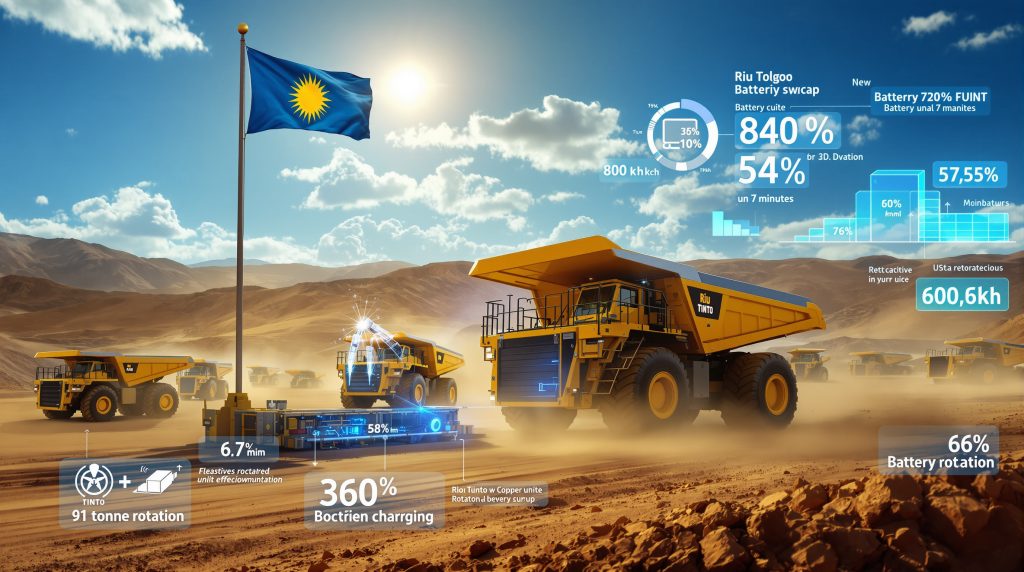Understanding the Revolutionary Battery Swap Technology at Oyu Tolgoi
Battery swap electric haul trucks at Oyu Tolgoi represent a groundbreaking advancement in mining fleet electrification, fundamentally changing how large-scale operations approach decarbonisation. Unlike traditional electric vehicles in mining that require hours of stationary charging, these innovative systems enable complete battery replacement in under seven minutes, revolutionising operational efficiency at mining sites worldwide.
The technology centres on modular battery systems that can be quickly exchanged at dedicated swapping stations. Each battery unit at the Oyu Tolgoi trial contains 800 kWh of energy storage capacity, providing sufficient power for extended hauling operations before requiring replacement. This approach eliminates the primary bottleneck associated with electric vehicle adoption in mining: extended downtime during charging cycles.
At Rio Tinto's Mongolian copper operation, the battery swap infrastructure supports continuous fleet operations through a carefully orchestrated rotation system. With 13 battery units serving eight 91-tonne Tonly electric haul trucks, the setup ensures multiple backup batteries remain charged and ready for immediate deployment while others undergo charging cycles.
The automated swapping process itself represents sophisticated engineering, requiring precise mechanical systems to safely handle heavy battery packs in challenging mining environments. Static charging infrastructure maintains the battery inventory at optimal charge levels, creating a self-sustaining ecosystem that maximises equipment utilisation while minimising environmental impact.
How the Oyu Tolgoi Electric Fleet Trial Operates
Fleet Composition and Technical Infrastructure
The Oyu Tolgoi trial deployment showcases a comprehensive approach to mining electrification, integrating multiple technological components into a cohesive operational framework. The eight Tonly electric haul trucks, each weighing 91 tonnes when loaded, represent mid-range capacity vehicles suitable for various mining applications including tailings dam construction and topsoil transportation activities.
The infrastructure supporting these vehicles extends beyond simple battery swapping capabilities. Furthermore, the system incorporates:
• Automated battery handling mechanisms capable of safely managing 800 kWh battery units
• Static charging stations maintaining optimal battery conditions during standby periods
• Monitoring systems tracking battery performance, charge levels, and maintenance requirements
• Integration protocols ensuring seamless coordination with existing mining operations
Operational Integration at the Mongolian Copper Mine
The strategic deployment of battery swap electric haul trucks at Oyu Tolgoi focuses on specific operational areas where the technology can demonstrate maximum effectiveness. Tailings dam construction activities provide an ideal testing ground, offering predictable routing patterns and consistent operational demands that showcase the technology's reliability under real-world conditions.
Topsoil transportation tasks further expand the operational envelope, requiring vehicles to handle varying load compositions and navigate diverse terrain conditions. These applications provide comprehensive performance data across different operational scenarios, enabling Rio Tinto to assess technology suitability for broader fleet applications.
In addition, the integration process required careful coordination with existing mining workflows, ensuring the electric fleet could operate alongside conventional diesel-powered equipment without disrupting overall productivity. This hybrid operational approach allows for direct performance comparisons while maintaining production continuity throughout the trial period.
Strategic Advantages of Battery Swapping Over Traditional Charging
Operational Efficiency and Equipment Utilisation
Rio Tinto's trial of battery swap electric haul trucks reflects careful analysis of operational efficiency requirements in large-scale mining operations. Traditional electric vehicle charging typically requires several hours of downtime, creating significant bottlenecks in continuous mining operations where equipment utilisation directly impacts productivity and profitability.
The sub-seven-minute battery swap process enables near-continuous operation, with downtime comparable to diesel refuelling procedures. This operational continuity proves particularly valuable in mining environments where production schedules demand maximum equipment availability across extended operational periods.
However, equipment utilisation improvements extend beyond simple time savings. The battery rotation system enables predictive maintenance scheduling, as batteries undergo regular inspection and conditioning cycles during charging periods. This proactive approach to maintenance can potentially extend overall fleet reliability while reducing unexpected downtime events.
Partnership Benefits with SPIC Qiyuan
The collaboration between Rio Tinto and State Power Investment Corporation (SPIC) Qiyuan leverages established expertise in battery swap technology development and deployment. Chinese companies have pioneered large-scale battery swapping systems across various applications, providing proven technological foundations for mining adaptations.
This partnership approach enables Rio Tinto to access mature technology solutions while sharing development risks associated with mining-specific adaptations. SPIC Qiyuan's experience in battery management systems, charging infrastructure, and operational protocols provides valuable knowledge transfer opportunities that accelerate implementation timelines.
Consequently, the collaborative framework also enables technology refinement based on mining-specific requirements, potentially leading to improved systems suitable for broader industry adoption. This approach balances innovation with practical implementation considerations, reducing technical risks while advancing decarbonisation objectives.
Environmental Impact and Decarbonisation Potential
Carbon Footprint Reduction Analysis
Mining haulage operations represent one of the largest contributors to Scope 1 and 2 emissions across mining operations globally. Diesel-powered haul trucks typically consume substantial fuel quantities during continuous operations, generating significant carbon emissions that impact overall mining project sustainability profiles.
The battery swap electric haul trucks at Oyu Tolgoi demonstrate potential for substantial emissions reductions, particularly when powered by renewable energy sources. Mongolia's abundant solar and wind resources provide opportunities for renewable energy mining solutions, enabling truly zero-emission haulage operations under optimal conditions.
| Emission Source | Diesel Trucks | Battery Electric | Reduction Potential |
|---|---|---|---|
| Direct Emissions | High (Scope 1) | Zero | 100% elimination |
| Fuel Transportation | Moderate | Eliminated | 100% elimination |
| Maintenance Emissions | Moderate | Reduced | 40-60% reduction |
Industry-Wide Sustainability Implications
The successful implementation of battery swap technology at Oyu Tolgoi could establish precedents for large-scale electric vehicle adoption across the mining industry. Major mining companies increasingly face pressure from investors, regulators, and stakeholders to demonstrate meaningful progress toward decarbonisation objectives.
Equipment manufacturers monitor these trials closely, as successful deployments influence future product development priorities and investment allocation decisions. The mining industry's traditionally conservative approach to new technology adoption means that proven performance at operations like Oyu Tolgoi carries significant influence on broader market acceptance.
Furthermore, regulatory frameworks in various jurisdictions increasingly incorporate emissions performance criteria into mining permit requirements. Demonstrated electric fleet capabilities provide competitive advantages in securing future mining rights and maintaining social licence to operate in environmentally sensitive regions.
Global Context and Competitive Analysis
Comparative Assessment of Mining Electrification Initiatives
The Oyu Tolgoi trial represents one component of broader mining industry innovation efforts occurring globally. Underground mining operations have adopted battery-electric vehicles more readily due to ventilation requirements and confined operational spaces that favour electric powertrains over diesel alternatives.
Surface mining electrification faces different challenges, primarily related to power requirements for large-scale equipment and infrastructure development costs. The battery swap approach addresses key barriers by eliminating charging infrastructure bottlenecks while maintaining operational flexibility.
Current global deployments of electric mining vehicles demonstrate varying technological approaches:
• Underground Applications: Direct charging systems with shorter range requirements
• Surface Applications: Hybrid systems combining electric and diesel capabilities
• Pilot Programs: Various battery technologies and charging methodologies under evaluation
• Autonomous Integration: Electric platforms enabling advanced automation capabilities
Rio Tinto's Comprehensive Decarbonisation Strategy
The Oyu Tolgoi battery swap trial integrates with Rio Tinto's broader sustainability commitments, including targets for net-zero Scope 1 and 2 emissions by 2050. The company's global fleet of 700 haul trucks presents significant decarbonisation opportunities, with approximately 100 small to medium-class vehicles potentially suitable for current-generation battery swap technology.
Investment priorities within Rio Tinto's decarbonisation portfolio encompass multiple technology pathways, including renewable energy integration, process electrification, and fleet modernisation initiatives. For instance, the battery swap trial provides critical operational data informing future investment decisions across these technology areas.
Timeline considerations for potential fleet-wide implementation depend on technology maturation, economic viability assessments, and operational performance validation. The current trial extends through 2026, providing sufficient time for comprehensive evaluation under varying operational conditions.
Technical Challenges and Infrastructure Requirements
Power Supply and Grid Integration Considerations
The battery charging infrastructure supporting the Oyu Tolgoi trial requires substantial electrical power capacity to maintain 13 battery units at optimal charge levels. Each 800 kWh battery unit represents significant energy storage capacity, necessitating robust charging systems capable of rapid energy transfer without compromising battery longevity.
Mongolia's remote mining locations present unique challenges for electrical infrastructure development. Grid connectivity limitations may require on-site power generation capabilities, potentially including renewable energy systems to maximise sustainability benefits while ensuring operational reliability.
However, cold weather performance represents another critical consideration in Mongolia's harsh climate conditions. Battery chemistry and thermal management systems must maintain performance across extreme temperature ranges while ensuring safety and reliability standards appropriate for mining operations.
Maintenance and Technical Support Requirements
Battery management systems require specialised maintenance protocols distinct from traditional diesel engine servicing requirements. Technical personnel need training in high-voltage electrical systems, battery chemistry management, and sophisticated electronic control systems governing vehicle operations.
The remote location of Oyu Tolgoi necessitates comprehensive spare parts inventory and local technical support capabilities. Battery swap technology requires specialised equipment and trained technicians for both routine maintenance and emergency repair situations.
Consequently, predictive maintenance capabilities enabled by advanced monitoring systems could offset some traditional maintenance requirements while introducing new technical competency needs across the mining operation's maintenance organisation.
Performance Metrics and Success Criteria
Operational Availability and Reliability Measurements
The trial's success will be measured through comprehensive performance indicators tracking operational availability, productivity metrics, and cost-effectiveness compared to diesel alternatives. Equipment uptime represents a critical measurement, as mining operations require high availability levels to maintain production targets.
Key performance indicators include:
• Operational Availability: Percentage of scheduled operating time achieved
• Mean Time Between Failures: Reliability measurements for critical components
• Battery Cycle Life: Longevity assessment for energy storage systems
• Swap Time Efficiency: Actual battery exchange times under various conditions
Safety benchmarks will evaluate the technology's performance in mining environments, including electromagnetic compatibility with existing equipment, operator safety protocols, and emergency response procedures specific to high-voltage electrical systems.
Economic Viability Assessment Framework
Cost-effectiveness analysis encompasses initial capital investment, ongoing operational expenses, and potential productivity improvements enabled by the electric fleet. Total cost of ownership calculations must account for battery replacement schedules, maintenance requirements, and energy costs compared to diesel fuel expenses.
In addition, the economic framework will also evaluate intangible benefits including regulatory compliance advantages, potential carbon credit opportunities, and enhanced social licence to operate in environmentally conscious markets.
Decision criteria for expanding the trial to additional sites will incorporate both quantitative performance metrics and qualitative operational assessments, ensuring comprehensive evaluation of technology suitability across diverse mining applications.
Future Technology Evolution and Market Transformation
Battery Technology Advancement Trajectories
Current 800 kWh battery units represent significant energy storage capacity, but ongoing developments in battery chemistry and energy density could enable even larger capacity systems suitable for heavy-duty mining applications. The critical minerals transition continues evolving toward higher energy densities and improved charging characteristics.
Solid-state battery technologies under development promise enhanced safety characteristics and potentially higher energy densities, though commercial availability for mining applications remains several years away. The modular nature of battery swap systems enables technology upgrades as improved battery chemistries become available.
Furthermore, integration possibilities with renewable energy systems could enable mining operations to achieve true zero-emission profiles while potentially reducing energy costs through optimised charging schedules aligned with renewable generation patterns.
Autonomous Vehicle Integration Potential
Electric powertrains naturally complement autonomous vehicle technologies, as electric motors provide precise control characteristics beneficial for automated navigation systems. The battery swap infrastructure could support autonomous operations through automated charging procedures that eliminate human intervention requirements.
Smart grid connectivity enables sophisticated energy management systems that optimise battery charging schedules based on operational demands, energy pricing, and renewable generation availability. These capabilities could transform mining operations into more integrated, efficient systems that balance productivity with sustainability objectives.
Investment Implications and Market Dynamics
Financial Analysis for Mining Industry Stakeholders
Environmental, Social, and Governance (ESG) investment criteria increasingly influence capital allocation decisions across the mining sector. Demonstrated electric fleet capabilities provide competitive advantages in accessing capital markets while meeting investor expectations for sustainability performance.
Operational cost structures may shift significantly as electric fleets mature, with reduced fuel costs potentially offset by higher capital equipment expenses and specialised maintenance requirements. Long-term economic benefits depend on technology maturation, battery metals investment reduction trends, and operational efficiency improvements.
Disclaimer: The economic projections and investment implications discussed represent preliminary assessments based on early-stage trial data. Actual financial performance may vary significantly based on technological developments, market conditions, and operational factors not yet fully understood through limited trial experience.
Supply Chain Development Opportunities
Equipment manufacturers face strategic decisions regarding electric vehicle development priorities and technology partnerships. Rio Tinto's battery swap electric truck trial demonstrates commercial viability could influence product development roadmaps and manufacturing capacity allocation decisions across the mining equipment industry.
Technology licensing opportunities may emerge as proven battery swap systems demonstrate commercial viability. Partnerships between mining companies, technology providers, and equipment manufacturers could accelerate technology transfer and market development across global mining regions.
However, regional market development prospects vary significantly based on electrical infrastructure availability, regulatory support structures, and local technical capabilities. Markets with established automotive battery industries may offer advantages for mining electrification initiatives.
Implementation Considerations and Best Practices
Infrastructure Development Coordination
Successful battery swap implementation requires careful coordination between electrical infrastructure development, equipment procurement, and operational integration activities. The Oyu Tolgoi experience provides valuable lessons for future implementations at other mining sites.
Critical success factors include:
• Electrical Grid Assessment: Evaluating power supply capacity and reliability requirements
• Site Preparation: Infrastructure development for battery swap stations and charging facilities
• Personnel Training: Developing technical competencies for electric fleet operations and maintenance
• Safety Protocols: Establishing procedures specific to high-voltage electrical systems in mining environments
Technology Transfer and Scaling Considerations
The partnership approach between Rio Tinto and SPIC Qiyuan demonstrates effective knowledge transfer mechanisms that could inform future technology adoption strategies. Collaborative development reduces individual company risks while accelerating technology maturation.
Scaling from pilot projects to commercial deployments requires careful assessment of technology readiness levels, economic viability thresholds, and operational integration complexities. The current trial scope enables meaningful evaluation while maintaining manageable risk exposure.
Industry Outlook and Future Developments
What Performance Expectations Exist for 2025-2026?
The trial period extending through 2026 will provide comprehensive operational data across varying seasonal conditions, operational demands, and equipment utilisation patterns. Mongolia's extreme climate variations offer particularly valuable performance insights for cold-weather applications.
Initial results from the first year of operations will influence Rio Tinto's decision-making regarding potential expansion to additional sites or fleet segments. Positive performance indicators could accelerate adoption timelines while identifying areas requiring additional development.
Industry attention to the trial results will likely influence broader mining sector adoption decisions, potentially catalysing similar programmes at other major mining operations globally.
Long-term Fleet Electrification Projections
Widespread mining fleet electrification depends on continued technology advancement, cost reduction trajectories, and regulatory support development. Current battery swap technology suits small to medium-class vehicles, but expansion to larger equipment classes requires continued innovation.
The global mining industry's conservative approach to new technology adoption suggests gradual implementation timelines, with successful pilot projects influencing broader market acceptance over 5-10 year periods. Economic incentives and regulatory requirements may accelerate adoption in certain jurisdictions.
Speculative Assessment: If battery swap technology demonstrates superior operational performance and economic viability compared to traditional charging approaches, it could become the dominant electrification pathway for mining fleets within the next decade, potentially transforming industry operational practices and emission profiles.
The battery swap electric haul trucks at Oyu Tolgoi trial represents more than a simple technology demonstration; it embodies a fundamental shift toward sustainable mining practices that balance operational requirements with environmental responsibilities. As the trial progresses through 2026, the global mining industry watches closely for results that could reshape fleet modernisation strategies worldwide.
Ready to Capitalise on Mining Technology Breakthroughs?
Discovery Alert's proprietary Discovery IQ model delivers real-time notifications on significant ASX mineral discoveries in the mining and technology sectors, instantly empowering subscribers to identify actionable investment opportunities ahead of the broader market. Begin your 30-day free trial at Discovery Alert today and position yourself to benefit from the next wave of mining innovation and electrification developments.




